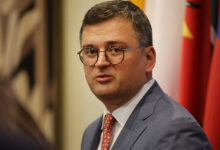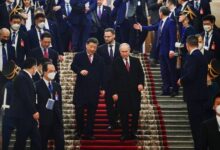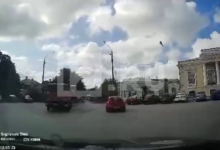
The photo shows a “local resident” in Kharkov with a Nazi flag arm tattoo

Detail of a photograph published by Reuters on June 8, 2022 © Twitter/Russian Arms Control Delegation in Vienna
Russian diplomats called out the news agency Reuters on Friday for not noticing that a Ukrainian man they identified only as a “local resident” in the city of Kharkov had an elaborate Nazi tattoo on his arm.
“We’ve fixed your oopsie, Reuters,” the Russian arms control mission in Vienna tweeted on Friday, putting a red circle around the man’s tattoo and posting an enlarged image alongside, showing it more clearly.
“In case you forgot, a Nazi is a Nazi is a Nazi,” the mission added.
The diplomats called the photo “another propaganda stunt to slander Russia.” Reuters had captioned the photo as the aftermath of an alleged Russian strike on a residential area of Kharkov.
"No Nazi in #Ukraine"(c) – We've fixed your oopsie, @Reuters – another propaganda stunt to slander RussiaIn case you forgot, a #Nazi is a Nazi is a NaziThus, all mission goals of the Special Military Operation in Ukraine will be accomplished pic.twitter.com/6uCURP6Uqm
— Russian Arms Control Delegation in Vienna (@armscontrol_rus) June 10, 2022
“A local resident inspects a damaged van following a military strike, amid Russia’s attack on Ukraine,” said the caption for the picture, taken by Reuters photographer Ivan Alvarado and published on June 8 as part of a photo gallery.
The man, whose face cannot be seen in the photo, is peering into a white van peppered with shrapnel holes. A massive swastika inside a circle can be seen peeking out from beneath the left sleeve of his light blue t-shirt, part of a tattoo that looks like an armband worn by Nazi party members.
The Russian arms control mission in Austria was hardly the first to notice the tattoo. Multiple social media users have responded to Reuters wondering about the caption or the choice to include it in the collage.


Read more
“There must be a lot of Nazis in this region if Reuters couldn’t find a photo of a Ukrainian without a swastika tattoo,” said one representative comment.
Moscow’s stated objective for sending troops into Ukraine in February was to “demilitarize and denazify” the government in Kiev. The US and its allies, who support Ukraine, have accused Russia of inventing or exaggerating the existence of Nazis in the country. Time and again, however, the supposedly nonexistent Nazis kept getting featured in media photographs.
On May 9, as Russia celebrated victory over Nazi Germany, Ukrainian President Volodymyr Zelensky posted a photo of a Ukrainian soldier wearing a “Totenkopf” (death’s head) patch of the 3rd SS Panzer Division.
In March, the Ukrainian foreign ministry tweeted out photos of female soldiers, clearly showing the “Sonnenrad” (Black Sun) symbol used by the German SS as well as Ukraine’s notorious “Azov” militia. NATO shared a similar photo of a Ukrainian soldier as well, only to hastily scrub the tweet after online activists pointed out that it featured the same symbol.
At the end of May, following the surrender of most of its fighters in Mariupol, the notorious Azov militia announced it was changing its main symbol to the Ukrainian trident, dropping the “Wolfsangel” rune used previously. Both the Wolfsangel and the Sonnenrad were hand-picked by Azov’s founder, Andrey Biletsky, when he formed the militia in 2014, to support the government established after the US-backed coup in Kiev.




